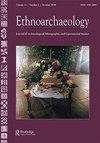北方森林燃料使用的民族考古学:对史前火相关活动的更好表征
IF 1.3
0 ARCHAEOLOGY
引用次数: 11
摘要
史前燃料管理和炉膛功能是实验和民族考古方法发展的关键研究问题,旨在为考古火和燃料研究提供解释模型。在本文中,我们选择了主要收集于东西伯利亚和北美的埃文克人和阿萨巴斯坎人的民族志、民族考古和民族历史资料。我们的目的是从民族考古学的角度来质疑和讨论燃料和灶台功能之间的关系:选择植物燃料的标准是什么?这些不同类型的燃料在考古学上的可见性如何?它们对过去与火有关的活动有什么启示?我们的数据表明,燃烧结构的内容是不同层次的人与环境相互作用的结果,其中很少有考古学家可以接触到。然而,民族考古学通过促进对广义上的埋藏学问题的反思,积极地促进了方法论的发展,从而更好地了解与火有关的复杂技术过程。本文章由计算机程序翻译,如有差异,请以英文原文为准。
Ethnoarchaeology of Fuel Use in Northern Forests: Towards a Better Characterization of Prehistoric Fire-Related Activities
ABSTRACT Prehistoric fuel management and hearth functions are key research issues that have benefitted from the development of experimental and ethnoarchaeogical approaches aimed at providing interpretative models for archaeological fire and fuel studies. In this paper, we present a selection of ethnographic, ethnoarchaeological and ethnohistorical data mostly collected among Evenks and Athabascans of East Siberia and North America. Our aim is to question and discuss the relationship between fuel and hearth functions from an ethnoarchaeobotanical perspective: what are the criteria for selecting plant fuels? How archaeologically visible can these diverse fuel types be and what do they tell us about past fire-related activities? Our data shows that the contents of combustion structures result from multiple people-environment interactions at different levels, few of which are accessible to the archaeologist. Nevertheless, ethnoarchaeology, by fostering a reflection on taphonomy issues in the broad sense, actively contributes to methodological developments leading to a better understanding of complex technical fire-related processes.
求助全文
通过发布文献求助,成功后即可免费获取论文全文。
去求助
来源期刊

Ethnoarchaeology
ARCHAEOLOGY-
CiteScore
1.60
自引率
0.00%
发文量
10
期刊介绍:
Ethnoarchaeology, a cross-cultural peer-reviewed journal, focuses on the present position, impact of, and future prospects of ethnoarchaeological and experimental studies approaches to anthropological research. The primary goal of this journal is to provide practitioners with an intellectual platform to showcase and appraise current research and theoretical and methodological directions for the 21st century. Although there has been an exponential increase in ethnoarchaeological and experimental research in the past thirty years, there is little that unifies or defines our subdiscipline. Ethnoarchaeology addresses this need, exploring what distinguishes ethnoarchaeological and experimental approaches, what methods connect practitioners, and what unique suite of research attributes we contribute to the better understanding of the human condition. In addition to research articles, the journal publishes book and other media reviews, periodic theme issues, and position statements by noted scholars.
 求助内容:
求助内容: 应助结果提醒方式:
应助结果提醒方式:


